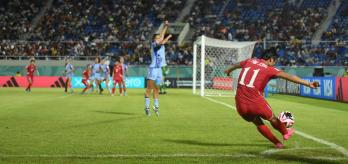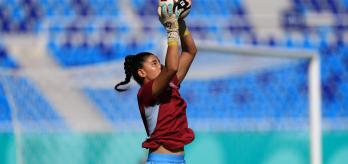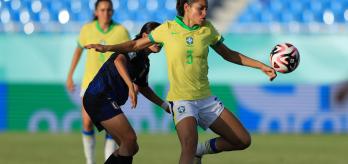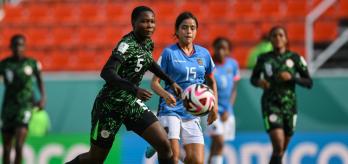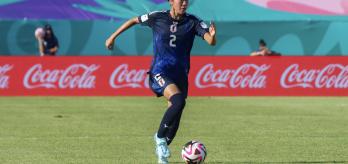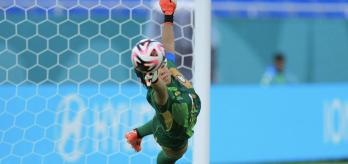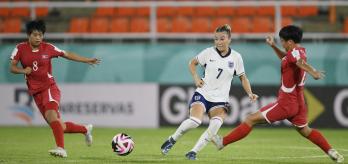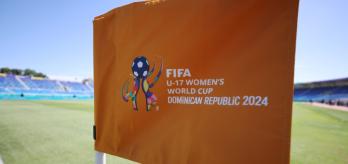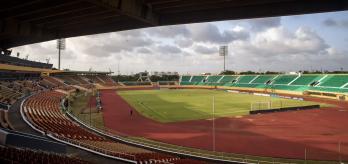During the FIFA U-17 Women’s World Cup Dominican Republic 2024™, our Technical Study Group closely assessed the technical skills of the players because these are key components of their potential to progress to senior level. Mastering these techniques is fundamental for young players because these skills are the tools required to implement effective tactical plans at the highest level.
A key in-possession skill that impressed our Technical Study Group (TSG) during this competition was players’ ability to use their first touch to evade pressure. One of the main ways in which players used this skill was to commit defenders to apply pressure, before taking them out of the game with a good first touch to progress the ball and therefore putting the defensive team in a more vulnerable position.
Variations of evading pressure with a first touch
Players were consistent in scanning before receiving the ball, gaining awareness of where the pressure was likely to come from, and where the space was available to exploit. They were clever in using their body orientation to trick defenders into thinking they are going to take their first touch in one direction before adapting or changing technique to take their first touch in another direction. For example, having their lower body orientated to move left but using the outside of the right foot to take the first touch to the right side. In addition, players also used the technique of taking a touch back towards where an oncoming defender had approached from, so the momentum of the pressing player carried them past the player in possession and opened up space to play in.
In the screenshots below, we see an example of how Brazil centre-back Sofia Couto (3) received the ball, understanding exactly where the pressure was coming from, and where the space was to exploit.
According to TSG member Vanessa Bernauer, “I really enjoyed watching how players did this, especially midfielders. They were scanning before receiving to understand where the pressure might come from, and I liked seeing this important detail and habit in such young players. This is a vital skill to have because then you can decide what you will do with the ball before you receive it, and this gives the player in possession an advantage. They know where they pressure is coming from and where they can go.
“Even some players who were not very technical could evade pressure with a clever first touch, but it all came from their game awareness, which was at a very high level for this age group. I was very impressed. Spain’s players were particularly consistent and competent in applying these technical skills, and it was such a pleasure to watch the levels of their players scanning, receiving and the execution of their next passes. This was one of the most standout and impressive aspects of this tournament for me,” explained the Switzerland international midfielder.
In the section below, our TSG have selected five clips to highlight some of the technical components used by players to deceive defenders with their first touch and progress the play in different phases of the game.
Decoy movement to set up first touch
In clip 1, Brazil centre-back Couto (3) uses a decoy body shape and movement to evade pressure as her team are building up their play. She appears to be in a closed position as the ball come towards her, tempting Zambia forward Mercy Chipasula (9) to leave Brazil right-back Helô Camargo (5) and commit to a straight, pressing run to force Couto to play backwards. As the ball approaches, she opens her body with a 90-degree pivot to her right, letting the ball run past her, evading the pressure. Her movement and first touch open up the right side of the pitch, and with Chipasula now out of the game, she plays forward to the unopposed Camargo, breaking the first line of Zambia’s defence.
Front-foot first touch to play forward
In clip 2, we see a great example of a player using their body orientation to commit and evade defensive pressure from their opponent. Prior to receiving the ball, Spain’s right-back, Martina González (2), consistently scans the pitch and has a clear understanding of where the pressure will come from and where the space is, should she receive the ball. As soon as the ball is played to her, Korea Republic left-back, Park Ji-yu engages (16), attempting to apply direct pressure. González anticipates this, and instead of closing her body to protect the ball from the press, she opens up the orientation of her right (receiving) foot and takes her first touch into the space behind, evading the press.
Committing the defender frontally before changing direction
Then, in clip 3, we see a clever decoy movement from England’s Vera Jones (10), who commits Mexico midfielder Monique Montes (6), before opening up the space behind her and playing a line-breaking forward pass. Jones is aware she can receive the ball in space and lets it run past her before taking her first touch. As her orientation opens up the pitch, she sees the incoming pressure from Montes who wants to show her down the line, but Jones recognises that both of her opponent’s feet are planted and opts to take her first touch inside. This movement eliminates Montes, who had committed to forcing her on the outside, and gives Jones significant space to exploit before playing an incisive forward pass.
Using first touch to roll a tight-marking defender
In clip 4, we see an example of ‘rolling’ a defender, whereby tight pressure being applied from behind the attacking player is evaded with a first touch into space either side of the committed defensive player. England forward Jane Oboavwoduo (20) makes movements to receive as her centre-back is stepping in with the ball. Once the left-winger receives the ball, Oboavwoduo makes a clever run across Mexico’s right centre-back Adrianna González (2). The defender tracks this run, getting touch-tight to Oboavwoduo as she receives the ball, applying direct pressure with the aim of preventing her opponent from playing forward. However, the England forward feels the contact and uses her body to protect the ball from the now-committed defender before taking her first touch to the outside right of her body, rolling the defender and advancing into the space behind.
Use of successive first touches to evade pressure in final third
Finally, in clip 5, we see a great example of how two of Spain’s forward players used their respective first touches to evade pressure in the final third in an attacking phase that leads to a goal being scored. As Iris Ashley Santiago (18) receives on the half turn in central space, she plays forward to Noa Ortega (7) on the right, who approaches the penalty area as she receives the ball. The Ecuador defender’s body shape indicates she expects Ortega to proceed straight towards the byline, but instead, Ortega cuts inside with her right foot, finding space to play forward to striker Celia Segura (9) who is tightly marked. As she uses her body to protect the ball, she rolls the defender by taking a clever first touch with the outside of her left foot, presenting her with space to strike at goal using her right foot and score.
Key take-aways
- Scanning before receiving to understand where pressure will come from and where the space is
- Being comfortable receiving under pressure
- Using body orientation to deceive the incoming defender
- Committing defenders to take them out of the immediate defensive situation
- Using the first touch to change direction
- Competence using different parts of the feet to take the first touch
- Explosive accelerations and agility to change direction at speed






